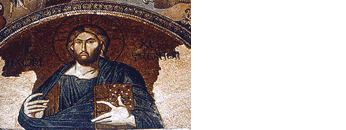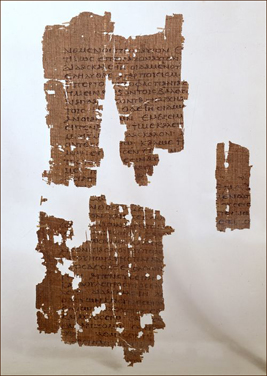
|
|
|
|
| Class
Prep |
|
|
|
Excavating the Gospels
 In order to get as close as possible to the historical man Jesus, we're going to have to identify which of the forty or so gospels are the earliest, and if possible even the sources embedded in them that predate them. The excerpt from the professor's book will give you the six most important early sources of the gospels. In class, we'll add three more: the Gospel of Peter, the Egerton Papyrus 2 (pictured to the right), and the so-called "Secret Gospel of Mark," which may be a modern hoax. In order to get as close as possible to the historical man Jesus, we're going to have to identify which of the forty or so gospels are the earliest, and if possible even the sources embedded in them that predate them. The excerpt from the professor's book will give you the six most important early sources of the gospels. In class, we'll add three more: the Gospel of Peter, the Egerton Papyrus 2 (pictured to the right), and the so-called "Secret Gospel of Mark," which may be a modern hoax. -
- Out of all of these sources, pay special attention to Q: it is broken out in The Complete Gospels into its own chapter. Drop in anywhere and review at least 10 sayings; write a paragraph characterizing Jesus' apparent emphases in his teaching here. This is likely our earliest source of his teaching, so it will be our central focus today.
-
- There is one other early source on the historical Jesus in the Bible, and that is the apostle Paul. He wrote seven letters that appear in the New Testament, and while he never knew the man Jesus, he reports a few traditions about him. Be able to identify some of the traditions he reports.
-
-
- Assigned Readings
-
-
| Primary: |
CG has isolated Q — a list of sayings of Jesus; drop in anywhere, read at least 10 logia (sayings), and write a paragraph characterizing Jesus' apparent emphases |
| Secondary: |
Murphy, HJFD 61-8 |
| Lecture Slides: |
Class 4a (pdf) |
-
-
- Further Reading
-
- Bell, H. Idris. "Fragments of an Unknown Gospel." British Museum Quarterly 9 (1934-1935) 71-3.
-
- Bell, H. Idris. and T. C. Skeat. Fragments of an Unknown Gospel. London: The Trustees [of the British Museum], 1935.
-
- Crossan, John Dominic. The Historical Jesus: The Life of a Mediterranean
Jewish Peasant, Hermeneia. San Francisco: HarperSanFrancisco, 1991.
-
- Draper, Jonathan A. "Wandering Charismatics and Scholarly
Circularities." In Whoever Hears You Hears Me: Prophets, Performance,
and Tradition in Q (ed. Richard A. Horsley with Jonathan A. Draper; Harrisburg,
Pennsylvania: Trinity Press International, 1999) 29-45.
-
- Kloppenborg,
John S. The Formation of Q: Trajectories in Ancient Wisdom Collections. Philadelphia:
Fortress, 1997.
-
- --------. Excavating
Q: The History and Setting of the Sayings Gospel. Minneapolis:
Fortress, 2000.
-
- Nicklas, T. "The 'Unknown Gospel': On Papyrus Egerton 2." In Gospel Fragments (ed. T. Nicklas, M. J. Kruger and T. J. Kraus; New York: Oxford University Press, 2009) 9-120.
-
-
Niederwimmer, Kurt. The Didache: A Commentary, trans. Linda
M. Maloney, ed. Harold W. Attridge, Hermeneia. Minneapolis: Fortress,
1998.
-
-
Patterson, Stephen J. The Gospel of Thomas and Jesus, Foundations
and Facets: Reference series. Sonoma, California: Polebridge, 1993.
-
-
Robinson, James M., Paul Hoffmann and John S. Kloppenborg, eds. The
Critical Edition of Q, Hermeneia. Minneapolis: Fortress, 2000.
-
- Theissen, Gerd. The First Followers of Jesus: A Sociological Analysis
of the Earliest Christians, trans. John Bowden. London: SCM, 1978;
German original, Munich: Chr. Kaiser, 1977.
-
-
- Links
-
- The
Lost Sayings Gospel Q - Hosted by Peter Kirby, with links to other useful
gospel resources.
- A
Synopsis for Q - A synopsis of the Matthean and Lukan sayings thought
to derive from Q, compiled by Peter Kirby using Young's Literal Translation.
- The Noncanonical
Home Page - Online access to all the so-called "hidden books" ("apocrypha")
of the Old and New Testaments, including Q, hosted by the Wesley Center for Applied
Theology.
- The
International Q Project - Hosted by the Institute for Antiquity and Christianity
at the Claremont Graduate University, Claremont, California.
- Egerton Papyrus 2 - The British Library has digitized many of its manuscripts, and on this page allows you to view the recto (front) and verso (back) of the Egerton Papyrus.
-
-
- Source of Photograph
-
- Egerton Papyrus 2 (P. Lond. Christ. 1/P. Egerton 2), on the page "Precious Papyri," British Library Medieval Manuscripts Blog (28 October 2013),
online, http://britishlibrary.typepad.co.uk/digitisedmanuscripts/2013/10/precious-papyri.html, accessed 24 April 2015.
|
|
|
|
|
